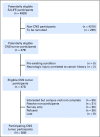Attainment of Functional and Social Independence in Adult Survivors of Pediatric CNS Tumors: A Report From the St Jude Lifetime Cohort Study
- PMID: 30091946
- PMCID: PMC6145833
- DOI: 10.1200/JCO.2018.77.9454
Attainment of Functional and Social Independence in Adult Survivors of Pediatric CNS Tumors: A Report From the St Jude Lifetime Cohort Study
Abstract
Purpose Beyond survival, achieving independence is a primary goal for adult survivors of pediatric CNS tumors. However, the prevalence of and risk factors for failure to achieve independence, assessed with multiple concurrent indicators, have not been examined. Patients and Methods Functional and social independence was assessed in 306 survivors (astrocytoma [n = 130], medulloblastoma [n = 77], ependymoma [n = 36], and other [n = 63]; median current age, 25.3 years [range, 18.9 to 53.1 years]; time since diagnosis, 16.8 years [range, 10.6 to 41.8 years]). Six observed indicators were used to identify latent classes of independence, which included employment, living independently, assistance with personal care, assistance with routine needs, obtaining a driver's license, and marital status. Physical performance impairments were defined as scores < 10th percentile on measures of aerobic capacity, strength, flexibility, balance, mobility, and adaptive function. Multinomial logistic regression estimated odds ratios (ORs) and 95% CIs were calculated for associations of disease/treatment exposures and impairments in physical performance with nonindependence. Results Three classes of independence were identified as independent (40%), moderately independent (34%), and nonindependent (26%). In multivariable models, craniospinal irradiation (OR, 4.20; 95% CI, 1.69 to 10.44) and younger age at diagnosis (OR, 1.24; 95% CI, 1.14 to 1.35) were associated with risk of nonindependence versus independence. Beyond impaired IQ, limitations in aerobic capacity (OR, 5.47; 95% CI, 1.78 to 16.76), flexibility (OR, 3.66; 95% CI, 1.11 to 12.03), and adaptive physical function (OR, 11.54; 95% CI, 3.57 to 37.27) were associated with nonindependence versus independence. Nonindependent survivors reported reduced physical but not mental health-related quality of life compared with independent survivors. Conclusion Sixty percent of survivors of pediatric CNS tumors do not achieve complete independence as adults. Reduction in intensity of primary therapies and interventions that target physical performance and adaptive deficits may help survivors to achieve greater independence.
Figures
Similar articles
-
Neurologic morbidity and functional independence in adult survivors of childhood cancer.Ann Clin Transl Neurol. 2024 Feb;11(2):291-301. doi: 10.1002/acn3.51951. Epub 2023 Nov 28. Ann Clin Transl Neurol. 2024. PMID: 38013658 Free PMC article.
-
Evolving therapies, neurocognitive outcomes, and functional independence in adult survivors of childhood glioma.J Natl Cancer Inst. 2024 Feb 8;116(2):288-298. doi: 10.1093/jnci/djad190. J Natl Cancer Inst. 2024. PMID: 37688569 Free PMC article.
-
Long-Term Neurocognitive Functioning and Social Attainment in Adult Survivors of Pediatric CNS Tumors: Results From the St Jude Lifetime Cohort Study.J Clin Oncol. 2016 Apr 20;34(12):1358-67. doi: 10.1200/JCO.2015.62.2589. Epub 2016 Feb 1. J Clin Oncol. 2016. PMID: 26834063 Free PMC article.
-
Social attainment in survivors of pediatric central nervous system tumors: a systematic review and meta-analysis from the Children's Oncology Group.J Cancer Surviv. 2019 Dec;13(6):921-931. doi: 10.1007/s11764-019-00808-3. Epub 2019 Oct 17. J Cancer Surviv. 2019. PMID: 31625086 Free PMC article.
-
Nutrition impact symptoms and associated outcomes in post-chemoradiotherapy head and neck cancer survivors: a systematic review.J Cancer Surviv. 2018 Aug;12(4):479-494. doi: 10.1007/s11764-018-0687-7. Epub 2018 Mar 20. J Cancer Surviv. 2018. PMID: 29556926
Cited by
-
Executive and social functioning in pediatric posterior fossa tumor survivors and healthy controls.Neurooncol Pract. 2022 Nov 7;10(2):152-161. doi: 10.1093/nop/npac090. eCollection 2023 Apr. Neurooncol Pract. 2022. PMID: 36970175 Free PMC article.
-
Feasibility and Acceptability Pilot Test of Connecting Latinos en Parejas: A Couples-Based HIV Prevention Intervention for Latino Male Couples.Am J Mens Health. 2023 Mar-Apr;17(2):15579883231167106. doi: 10.1177/15579883231167106. Am J Mens Health. 2023. PMID: 37096329 Free PMC article.
-
Adolescents and Young Adults With Cancer: CNS Tumors.J Clin Oncol. 2024 Feb 20;42(6):686-695. doi: 10.1200/JCO.23.01747. Epub 2023 Dec 8. J Clin Oncol. 2024. PMID: 38064656 Free PMC article. Review.
-
Longitudinal associations between exposure to anesthesia and neurocognitive functioning in pediatric medulloblastoma.Eur J Cancer. 2021 May;148:103-111. doi: 10.1016/j.ejca.2021.02.010. Epub 2021 Mar 17. Eur J Cancer. 2021. PMID: 33743477 Free PMC article.
-
Predicting neurocognitive function in pediatric brain tumor early survivorship: The neurological predictor scale and the incremental validity of tumor size.Pediatr Blood Cancer. 2022 Sep;69(9):e29803. doi: 10.1002/pbc.29803. Epub 2022 Jun 16. Pediatr Blood Cancer. 2022. PMID: 35709014 Free PMC article.
References
-
- Howlader N, Noone AM, Krapcho M, et al: SEER Cancer Statistics Review, 1975-2014. Bethesda, MD, National Cancer Institute, 2017.
-
- Packer RJ, Gurney JG, Punyko JA, et al. Long-term neurologic and neurosensory sequelae in adult survivors of a childhood brain tumor: Childhood Cancer Survivor Study. J Clin Oncol. 2003;21:3255–3261. - PubMed
Publication types
MeSH terms
Grants and funding
LinkOut - more resources
Full Text Sources
Other Literature Sources
Medical



